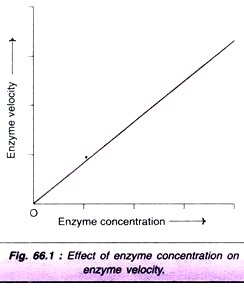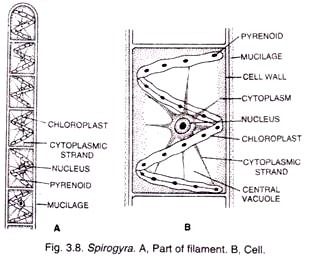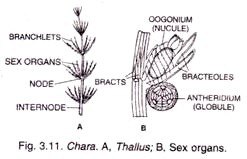ADVERTISEMENTS:
In this article we will discuss about:- 1. Characters of Green Algae 2. Common Types of Green Algae 3. Economic Importance 4. Green Algae as Ancestors of Land Plants.
Characters of Green Algae:
Green algae are defined as a group of eukaryotic algae which resemble land plants in having cellulosic cell wall, starch as food reserve and both chlorophyll a as well as chlorophyll b as photosynthetic pigments.
1. The group contains about 7000 living species.
ADVERTISEMENTS:
2. Green algae occur in all types of habitats. Only ten percent of green algae are marine. Majority of the species are fresh water. Several members are sub-aerial. They grow on moist soils, walls, rocks and tree trunks. Strains of Chlorella can bear moderate hot waters. Some forms live in snow or frozen lakes (e.g., Seotiella, Homidium).
3. Some species are epiphytic, endophytic, epizoic or endozoic. Zoo-chlorella is associated with sponges. Characium occurs on crustaceans, Cladophora on molluscan shells, while Trichophilus provides green colour to the fur of tree-dwelling sloth (a mammal) found in the rain forests of South America.
The alga gives protective colouration to the sloth. Certain green algae are constituents of lichens. Cephaleuros is parasitic on a number of higher plants. It reduces the yield of tea, coffee, pepper and citrus fruits.
4. Thallus is various— unicellular flagellate (e.g. Chlamydomonas), unicellular non-flagellate (e.g. Chlorella, Characium, Ac- etabularia or umbrella plant which is several centimeters in length and is differentiated into uni-nucleate holdfast, an elongated stalk and umbrella-like cap.), flagellate colonies (e.g. Volvox), non-flagellate colonies (e.g. Scenedesmus, Hydrodictyon), coenocytic and siphonaceous (e.g. Caulerpa), heterotrichous (with prostrate and vertical branches, e.g. Draparnaldia), and parenchymatous (e.g., Ulva).
ADVERTISEMENTS:
5. Cell wall contains cellulose with a few exceptions.
6. Chloroplasts have 2-20 thylakoid lamellae.
7. Photosynthetic pigments are similar to those of higher plants— chlorophyll a, chlorophyll b, carotenes and xanthophyll’s. The colour is grass-green due to predominance of chlorophylls.
8. Food reserve is starch.
9. Chloroplasts generally contain 1 to many pyrenoids for storage of starch.
10. In flagellate forms, an eye spot is present in the chloroplasts.
11. Asexual reproduction takes place by both mitospores and meiospores. The common asexual spores are zoospores, aplanospores, hypnospores, akinetes, autospores, etc.
12. Sexual reproduction is effected by isogamy, anisogamy and oogamy. In isogamy both the fusing gametes are morphologically and physiologically similar. They may be flagellate or non-flagellate. In anisogamy the fusing gametes are structurally similar but differ in size and behaviour.
ADVERTISEMENTS:
One of the two gametes is larger and is called macrogamete or female gamete. The other is smaller and is termed microgamete or male gamete. In oogamy there is a large food laden non-flagellate female gamete called egg or oosphere. The male gamete or antherozoid is smaller and motile.
Common Types of Green Algae:
Some of the important types and the importance of green algae are as follows:
1. Chlamydomonas:
It is a microscopic (10-30 nm), eukaryotic, unicellular, pyriform, biflagellate green alga of both fresh water and marine habitats, generally rich in ammonia salts. Cell wall consists of glycoprotein.
ADVERTISEMENTS:
Cellulose is absent. There is an apical papilla. Internally, the alga possesses a single nucleus, two contractile vacuoles for osmoregulation and excretion, a cup-shaped chloroplast with a red eye spot or stigma and a pyrenoid for storing starch.
Asexual reproduction occurs through formation of zoospores, aplanospores, hypnospores and palmella stage. In palmella stage, a large number of near naked cells devoid of flagella lie inside a mass of mucilage. The stage develops in response to toxic chemicals and unfavorable water conditions.
Zoospores are flagellate spores while aplanospores and hypnospores are non-motile. Aplanospores are thin-walled. Hypnospores are thick-walled.
ADVERTISEMENTS:
They often possess reddish pigment haematochrome. Red snow caused by C. nivalis is due to red coloured hypnospores. Sexual reproduction can occur by isogamy, hologamy (fusion of young cells), anisogamy and oogamy. It shows zygotic meiosis and thus life cycle is haplontic.
2. Volvox:
It is a fresh water green hollow ball like colonial alga of 0.5-2 mm diameter. Colony of Volvox is hollow and has a fixed number of cells (500 to 60,000). It is called coenobium. The cells are interconnected by cytoplasmic strands.
They are biflagellate. Some cells of the posterior region are large. They function as reproductive cells or gonidia. The whole colony or coenobium swims by joint activity of its flagellate cells. The alga rotates during swimming. It is, therefore, also called rolling alga. Asexual reproduction occurs by formation of daughter colonies. Sexual reproduction is oogamous.
3. Ulothrix:
It is an attached, un-branched, green, filamentous alga of fresh aerated waters. Filaments are covered by mucilage. They are attached to a solid substratum by means of a colourless lowermost cell called holdfast. The remaining cells are green. They are cylindrical and quadrate. The cells are uninucleate. They have central vacuoles.
The peripheral protoplast possesses a single girdle-like or collar shaped chloroplast studded with a few pyrenoids. Every green cell is capable of growth, photosynthesis and reproduction. Vegetative reproduction occurs through fragmentation. Asexual reproduction takes place through zoospores, aplanospores, hypnospores and akinetes.
Sexual reproduction is isogamous. Life cycle haplontic.
4. Spirogyra:
ADVERTISEMENTS:
It is an un-branched, mucilage covered green filamentous alga that forms free floating masses over the surface of fresh water ponds. It is called pond scum, water silk or mermaid tresses. All the cells are green, elongated, cylindrical, capable of growth, division and taking part in reproduction.
A non-green holdfast occurs in attached species. A green cell contains 1-16 spirally coiled ribbon shaped chloroplasts studded with medianly arranged pyrenoids. There is a single nucleus suspended in the central vacuole by means of cytoplasmic strands.
Spirogyra multiplies vegetatively by fragmentation. Asexual reproduction by spores is rare. Sexual reproduction occurs by conjugation. Conjugation occurs by two methods, scalanform conjugation and lateral conjugation.
In scalariform conjugation opposite cells of two filaments develop conjugation tubes. Gamete of one cell called male gamete is more active, passes through conjugation tube and fuses with gamete or female gamete of the cell of the second filament.
In lateral conjugation, two adjacent cells of the same filament function as male and female cells. Male gamete passes into female cell either through a conjugation tube (indirect lateral conjugation, e.g., S affinis) or through a central pore (direct lateral, e.g., S. jogensis).
ADVERTISEMENTS:
Zygote develops into a resting thick walled zygospore. On approach of favourable season next year, zygospore undergoes meiosis but produces only a single filament due to degeneration of three of the four haploid nuclei. Development of zygote is direct. Life cycle is haplontic.
5. Chara:
Chara or aquatic horsetail is a green alga found growing at the bottom of shallow fresh waters like ponds, pools and lakes. Lime incrustation may occur in some species (hence stonewort). Chara is food for many aquatic animals. It can be used as manure. Mosquito larvae do not occur in Chara waters.The plant is fixed to the substratum by means of highly branched multicellular rhizoids.
The axis of the plant is jointed. The joints represent nodes having whorls of short laterals with an occasional long lateral. Male sex organ is rounded called antheridium (= globule). It lies below the ovate shaped female sex organ called oogonium (= nucule).
Both antheridium and oogonium have multicellular coverings which bring them close to sex organs of bryophytes. Chara can multiply vegetatively through fragmentation, tubers, bulbils, asylum stars and secondary protonemata.
Economic Importance of Green Algae:
ADVERTISEMENTS:
1. Food:
A number of green algae are used as food, e.g., Ulva, Caulerpa, Enteromorpha. Chlorella can yield food rich in lipids, proteins, vitamins and minerals.
2. Antibiotics:
They can be extracted from Chlorella and Caulerpa.
3. Parasites:
Cephaleuros virescens causes red rust of tea and reduces yield of tea. It also reduces the yield of coffee, pepper, citrus, etc.
4. Sewage Oxidation:
Sewage oxidation ponds contain a number of green algae, e.g., Chlamydomonas, Chlorella, Scenedesmus.
Green Algae as Ancestors of Land Plants:
There are no biochemical, cytological and morphological similarities between land plants and any other group of algae except the green ones or chlorophyta.
The various evidences which favour the chlorophycean origin of land plants are:
(i) Both green algae and land plants possess the same type of chlorophylls, a and b.
(ii) The carotenoid pigments are similar in the two groups.
(iii) Cell wall contains similar cellulose and pectic compounds in the two groups.
(iv) Starch is the common storage carbohydrate in the two groups.
(v) The flagella are similar in the motile forms of the two.






